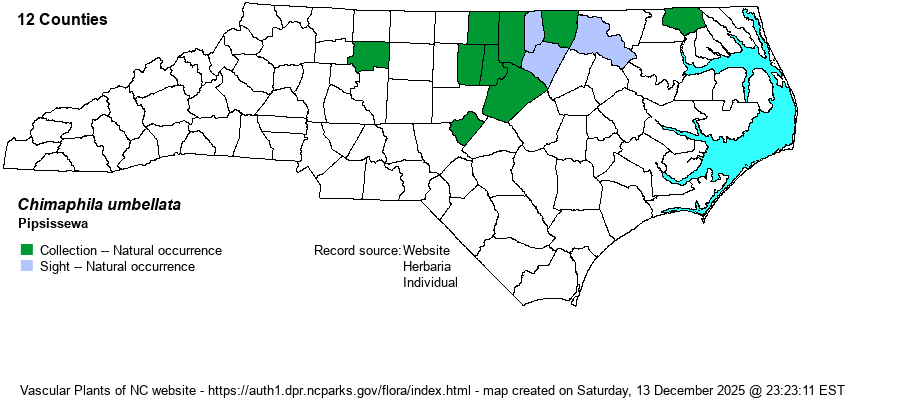| Author | (L.) W.P.C. Barton | |
| Distribution | Quite limited in the state, compared with Chimaphila maculata. It is found only in the northeastern Piedmont (with the exception of a collection in Forsyth County), and very sparsely in the extreme northern Coastal Plain near the VA border. Shockingly, there is not a single photo of this species on iNaturalist for the state, and the last collection date in SERNEC is 1991.
As expected from the state range, this is a Northern species occurring across all of Canada and the western U.S., but in the East ranges south only to northern NC, northern IN, and IA. It is not known from KY or TN. | |
| Abundance | Strongly declining, and now rare in VA border counties from Person on the west to Gates on the east, and very rare in the next tier southward (i.e., Orange, Durham, Wake, Franklin, and Halifax counties). Very rare in other parts of the NC range. The NCNHP has placed the species -- technically the sole variety in NC -- on its Watch List, in 2024. The website editors feel that the S2S3 State Rank is, in 2025, far too liberal, and S1S2, if not even S1, is now appropriate. | |
| Habitat | This species grows in quite similar habitats as those of its cousin -- C. maculata. It is found in strongly acidic soils of pine forests and mixed pine-hardwood forests, generally in uplands. It rarely can be found in upland hardwood stands. | |
| Phenology | Flowers in May and June, mainly starting in late May. Fruits from July to October. | |
| Identification | This is a very low-growing evergreen subshrub, similar in growth form to C. maculata. Thus, it contains a handful of leaves, mostly crowded toward the top of the stem, which reaches only 4-6 inches high, on average. The dark green leaves are not striped in white but are solid in color, quite shiny above, and thick; they are sharply toothed but are oblanceolate (wider above the middle) instead of lanceolate as in C. maculata. The handful of small flowers, with 5 waxy petals, are white to pink. Flowers are hard to spot in NC simply because 1) the species is scarce, and 2) it tends to bloom just for about 2-3 weeks in early summer. Thankfully, as it is evergreen, it can be spotted and easily identified even in winter. | |
| Taxonomic Comments | A few varieties have been named by some authorities. Only C. umbellata var. cisatlantica is known to occur in NC.
| |
| Other Common Name(s) | Prince's-pine | |
| State Rank | S2S3 [S1S2] | |
| Global Rank | G5 | |
| State Status | [W1] | |
| US Status | | |
| USACE-agcp | | |
| USACE-emp | | |

